Smoked Beef Back Ribs
These smoked beef back ribs are smoked low-and-slow until they reach the best ever juicy, tender, melt-in-your-mouth texture! The outside caramelizes beautifully, and the meat pulls right off the bone! Follow this easy 3 step method for effortlessly amazing smoked beef ribs!
Servings: 4 servings
Calories: 198kcal
Ingredients
Beef Back Rib Dry Rub
- 2 tablespoon olive oil (extra virgin)
- 1 steak seasoning ( 1 portion per rack)
Beef Back Ribs
- 1 rack beef back ribs (silverskin removed)
- 8 tablespoon barbecue sauce (pick your favorite)
- 2 tablespoon unsalted butter
- 2 tablespoon apple cider vinegar
- 2 tablespoon dark brown sugar
Instructions
- Get your ribs ready for smoking by removing the silverskin. Use your fingers or a butter knife to work under the edges and pull the membrane off the underside of the ribs. Preheat your smoker to 225°F (110°C) and load your wood chips or pellets.
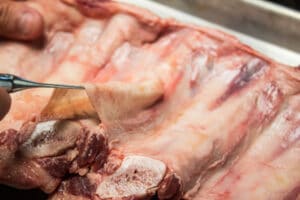
- Apply a coating of olive oil and then coat the entire rib rack with dry rub.
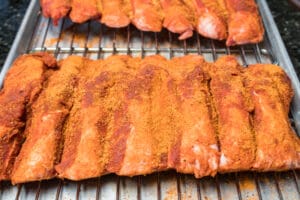
- Place the ribs with the bone side facing downward (the side that you removed the silverskin from) and smoke for 3 hours.
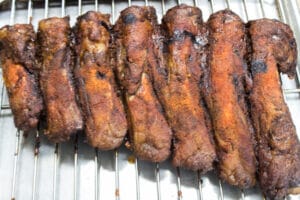
- Remove the ribs from your smoker and set them on large enough sheets of aluminum foil to wrap the ribs securely. Add the butter, brown sugar, and apple cider vinegar to the ribs, then wrap and seal. Return to your smoker and continue to smoke for another 2 hours.
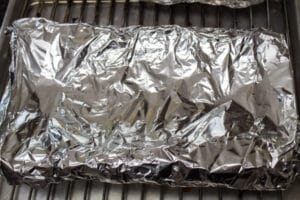
- Remove the ribs from your smoker. Unwrap the ribs and coat with your favorite barbecue sauce. Return to the smoker and place the ribs bone side down. Smoke for an additional hour, or until an internal temperature of 202-205°F (94-96°C) has been reached. Use a digital meat thermometer to check your meat for doneness.
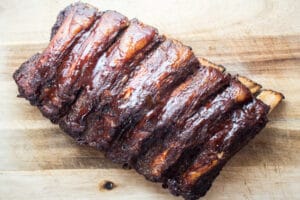
Notes
- Apple juice is a good alternative to apple cider vinegar if you're worried about the vinegar flavor diminishing the smoked beef or rub flavor in any way. Psst! Don't worry about that, they taste A-M-A-Z-I-N-G!
- You want to remove the silverskin (aka membrane) because it allows more smoke to penetrate into the meat. Setting your beef back ribs with the silverskin side down ( and in place still ) would block the smoke from really permeating the meat from the underside.
- The USDA does not recommend rinsing raw meats, but it is something I always do. I can't stand the little bone fragments occasionally found on ribs. However, if you choose to rinse the ribs, you should be extra thorough when sanitizing your kitchen after preparing your ribs.
- As beef ribs are very rich, the rub should be heavier on beef ribs v.s. brisket, for example. I typically will use about ¼ cup of dry rub per rib rack.
Nutrition
Calories: 198kcal | Carbohydrates: 20g | Protein: 1g | Fat: 13g | Saturated Fat: 5g | Cholesterol: 15mg | Sodium: 363mg | Potassium: 81mg | Fiber: 1g | Sugar: 17g | Vitamin A: 256IU | Vitamin C: 1mg | Calcium: 17mg | Iron: 1mg